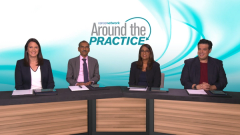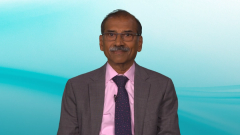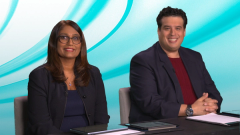
Induction Therapy Options for Patients With Transplant-Ineligible NDMM
Expert perspectives on cornerstone induction therapy regimens used in patients with transplant-ineligible newly diagnosed multiple myeloma.
Episodes in this series

Transcript:
Sundar Jagannath, MD: Tell me something about the MAIA study in this patient population.
Adriana Rossi, MD: This was very much the basis for her treatment. The MAIA study compared what was considered a standard of care, which is lenalidomide-dexamethasone, with the addition of daratumumab up front in the transplant-ineligible patients. Not surprisingly, the triplet did better than the doublet, with not only overall response but also the MRD [minimal residual disease]–negativity rate. Now we have data on sustained MRD negativity. In this case, the 6 months sustained did not translate into 12 months. So 1 concern is with the attainment of deeper MRD rates. Are we translating that into the benefit as you’re saying in these older patients who may not get to their second-line salvage? Overall survival remains the same, but overall survival with our numerous salvage options becomes a less impressive state. But it’s solidly made its way into the new standard of care.
Sundar Jagannath, MD: You talked about MRD. It’s very interesting in older patients. Do you check their bone marrow for MRD every year or at a fixed-time interval, as we do in transplant-eligible or younger patients?
Adriana Rossi, MD: I offer it to them. I don’t talk them into anything. But when they appreciate what it could mean, they start the clock: maybe this could translate to being off therapy and changing this paradigm of continuous therapy being required. As I tried to illustrate in this case, this was through the COVID-19 pandemic, which threw a wrench in a lot of things. [Then, instead of] doing what’s evidence based, [we were] doing what we could and learning lessons from our experience. She didn’t have an interim biopsy. Other than her diagnostic biopsy, her first biopsy was for MRD negativity once she attained the CR [complete response]. But yes, I’ll offer it to her next year if she’s still with me.
Sundar Jagannath, MD: I would anyway, not only when a patient achieves complete remission to check for MRD. Once it’s serologically visible, you don’t need MRD to look for it.
Adriana Rossi, MD: Agreed.
Sundar Jagannath, MD: The first trial introducing lenalidomide-dexamethasone was an international trial, in which Rd [lenalidomide, dexamethasone] became established as a good treatment for transplant-ineligible patients predominantly. After that, we have the SWOG-S0777 trial, which was Rd [lenalidomide, dexamethasone] vs VRd [bortezomib, lenalidomide, dexamethasone]. VRd [bortezomib, lenalidomide, dexamethasone] was better. Now you have the addition of daratumumab to Revlimid [lenalidomide]. How would you compare the MAIA trial with the SWOG-S0777, or the Rd [lenalidomide, dexamethasone]–vs–VRd [bortezomib, lenalidomide, dexamethasone] trial?
Adriana Rossi, MD: Our 2 primary triplets do remarkably similar as far as numbers. The PFS [progression-free survival] remains very similar from the 50s to the 60s. But overall survival [has] no benefit because we’re getting better at salvaging them. Bortezomib is a difficult drug with neuropathy, in patients who already have it or [if we want them to] avoid getting it. We’re not doing a very good job of treating peripheral neuropathy, so that’s a large argument. We have a lot of data for proteosome inhibitors in high-risk cytogenetics. As data mature, the daratumumab data will be very similar. Either triplet will get you the response. It’s mostly mitigating toxicity and finding a regimen that these patients can stay on and sustain.
Transcript edited for clarity.
Newsletter
Stay up to date on recent advances in the multidisciplinary approach to cancer.





















































































